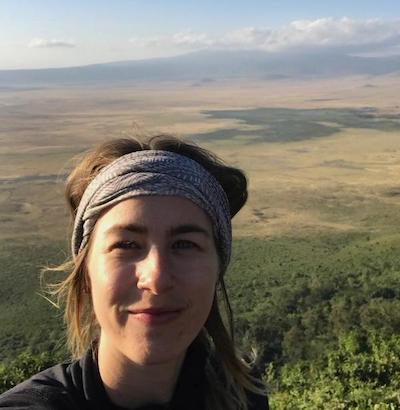Written by Vanessa Bateman, Anthropogeny Specialization Track Graduate Student (UC San Diego Dept. of Visual Arts; Art History, Theory and Criticism).
Joining the Graduate Specialization in Anthropogeny track was the best decision I made while completing a PhD in Art History, Theory, and Criticism at UC San Diego and has shaped the trajectory of my research after graduation. Out of a curiosity to gain insight about my research on the visual representation of hunting from a different perspective, I enrolled in the Introduction to Anthropogeny course taught by Prof. Pascal Gagneux in the Fall of 2016. During the course, I remember asking Pascal why we didn’t discuss the earliest forms of visual representation and he distinctly said, “because it is too recent!” This struck me as both frustrating and intriguing as I had naively taken the course to gain insight into early forms of art, but the knowledge and questions I ended up with at the end of the course were broader and more fundamental to the very existence of my topic in the first place. What followed the introductory seminar were four years in the Specialization in Anthropogeny program where I was given an outlet to address these larger questions alongside my own research. While in the beginning, I felt that my own work was too remote from the study of human origins and the research of my colleagues, I came to realize just how much the knowledge gained from discussions with faculty, students, and visiting scholars, seminars and symposiums have been applicable to my dissertation.
At each CARTA symposium, I am always impressed by how one theme can be addressed from so many perspectives, illustrated by the speakers I hosted who came from the disciplines of Archaeology, Computer Science, Visual Arts, and Anthropology. Throughout the years I have witnessed just how productive and important the transdisciplinary nature of CARTA is, especially through discussions with my colleagues who each offer distinct viewpoints from their own disciplines. To be honest, my time in the Anthropogeny track provided the most thought-provoking conversations I had in graduate school, (especially over a meal of Pascal’s bread and honey) with an ever-evolving appreciation about human origins research, but also what it means to be a modern human. I am incredibly thankful to the CARTA staff, faculty and students who made this experience such a vital part of my time at UC San Diego.
Last summer (2019) I was fortunate to participate in the Anthropogeny Field Course in East Africa, providing me with an immersive understanding of not only studying human origins in the field but also gaining insight into what it was like to live like our early ancestors by moving through the same landscape and witnessing the ways of life of hunter-gatherers. This unparalleled educational (and life) experience gave me the opportunity to see and touch stone tools dating to over a million years and some of the most important fossilized specimens to the current understanding of human origins, highlighted by the skeletal remains of Ardipithecus ramidus shown to us by Tim White at the National Museum of Ethiopia. In Tanzania we moved through the Ngorongoro Crater and the Serengeti witnessing the sublime landscape and its diverse geology, animals, and people, joyously stumbling upon two panting cheetahs with their freshly killed gazelle. During our time with the Hadza we witnessed their mastery of hunting and gathering and relished in a chance to taste their freshly collected honey. We got to meet Jane Goodall’s chimpanzees at Gombe National Park followed by time at the Greater Mahale Ecosystem Research and Conservation (GMERC) project for primate research and conservation in the Issa Valley, Western Tanzania, where we spent quality time with more recently habituated chimpanzees by shadowing field assistants. The vivid memories of the field course have clearly not faded, nor will they anytime soon, and they exemplify the variety of perspectives needed to gain an understanding of where we came from and how we got here. Where am I going? After graduating next fall I hope to complete a postdoctoral study on the visual (modern) representations of early humans in museums and scientific publications.


